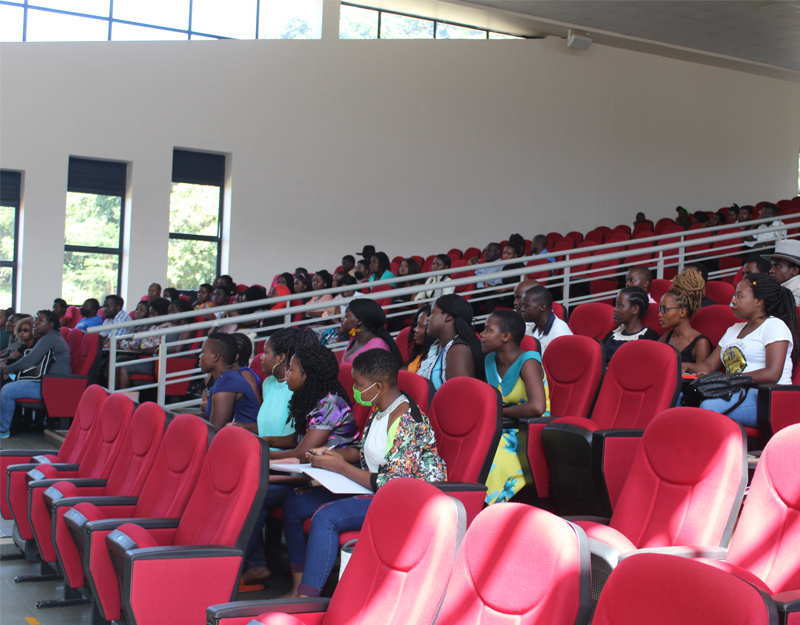NATURAL TAPESTRIES EXHIBITION IN THE FPA DEPARTMENT
All the artists are alumni of Chancellor College. The exhibition featured a total of 28 artworks, rendered in a variety of materials. The majority of the artworks were paintings, but the show was also spiced with two items of sculpture.
Although the paintings featured a variety of themes, one of the dominant factors that stood out was the emphasis on nature, in all its admirable as well as terrifying beauty. In this regard, through utter coincidence, all of the artists appear to feature flora in one way or the other. The dominance of nature is emphasized by the fact that there is minimal human intrusion in the images. According to the artists, all three art styles – expressionism, conceptual art, and realism – featured during the exhibition takes their cue from nature.
For example, the very first painting that one encounters upon walking into the show is Desderio Galagade’s Flora, a huge canvas spread featuring red and white flowers in bloom, set against a cream background. Walking through the room, one realizes the painting has cousins, other floral-themed works of art, such as the colorful Autumn Leaves, featuring suggestive petal patterns of yellow and hints of blue, striking against a dark background; and Swampy Beauty, an arresting display of orange and purple tulips waving in the wind. Galagade has a signature move that accompanies most of his painting – a final set of splashes on the canvas, which he explains as an inspiration from the American painter Jason Pollock. Galagade uses it to accentuate the rhythm inherent in his work.
Nature also takes centre-stage in Steve Chanyenga’s work. Interestingly, however, his work mixes the notion of nature with a subtle insistence on its connection with Afrocentricity. It is as though he is insisting that the two are inseparable, that in Africa is where nature is in its most ‘natural’ form, so to say. One of the paintings conveying this idea is a painting simply entitled Women at a Water Place, depicting three women ankle deep in a river. Two of the women are drawing water from the river, while the third – in the foreground – washes her feet. In this painting, the presence of nature is supported by the arid landscape in the background. On the bottom-left of the painting, easily missed, is a humming bird in the process of drawing nectar from a flower. In viewing this painting, one gets a strong impression of a harmonious relationship between man (or in this case – woman) and nature. The women come to draw water, but also to bathe at the river. Similarly, a painting entitled Africa, a beautiful place depicts an antelope drinking at a florally resplendent waterhole. Two trees grow out of the waterhole, and their branches artistically form the shape of the continent. Chanyenga’s other interests seem to be in music, evidenced by a trio of paintings, rendered in cubist style, depicting figures playing various locally made musical instruments.
Michael Chilemba is also not to be outdone on the natural scene, featuring colorful paintings such as Aftergraze, a monotone rendering of a zebra that seems to look into the very soul of the viewer, as though challenging us to decide who is the beast – the gazer or the gazed at. Furthermore, this creature seems to catch the viewer in an embarrassing voyeuristic moment, silently reminding us of our love for gazing, as though the gaze itself could arrest, or could define, the reality of the picture. Yet in that very moment of looking at us, the painted creature makes us wonder if we are engaged in a moment of role reversal, if we become the gazed at, if we take subject position in the interaction with the painting. Still on the nature theme, Chilemba next shifts his skill to Fruit, a vivid rendering of melon slices. This painting, with its bright reds greens and yellows, is an exemplar of how the artist, in contrast to Platonic beliefs, sometimes renders realities that are more pleasing that the seemingly desaturated world that surrounds us.
Upon visiting the exhibition, the Dean of Humanities, Associate Professor Syned Mthatiwa, was full of praise for the artists: “This exhibition gives us the confidence to believe that our students are getting the necessary training and guidance in artistic expression, the sort of training that will make them the great artists this country needs. The artistic works exhibited here also reveal to us that our artists have the potential and capacity to compete with the best on the international scene. My hearty congratulations to all artists whose works are showcased here”.



